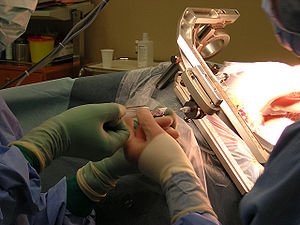
- Image via Wikipedia
A tiny device at the site to report on growth of a tumor
DOCTORS doing a needle biopsy to analyze tissue for cancer may one day add a second step to the procedure: depositing a tiny device at the site to report on growth of a tumor — and even the effects of chemotherapy.
Researchers at the Massachusetts Institute of Technology have created prototypes for cancer monitors the size of a grain of rice, small enough to fit easily into the bore of a biopsy needle. Tiny coated particles inside the devices can bind with molecules linked to cancer at the site, creating minuscule clumps that can be detected by a non-invasive scan like an M.R.I., said Michael J. Cima, a professor of materials science and engineering at M.I.T. and leader of the team that created the devices.
Dr. Cima tested the tiny monitors in mice. “The devices were highly sensitive,” he said. “We were able to show that in mice that had the cancer, we could detect it with the change in the M.R.I.”
The limits of existing biopsies spurred the idea for the monitors, he said.
“The biopsy is the gold standard for diagnosis,” he said. “But the downside is that you only get a measurement at the time you take the tissue.”
By contrast, the monitors can offer continuous information. “For example,” he said, “instead of trying a chemotherapy and waiting a while, you could see early indications of whether the therapy was going to work.”
Dr. Cima’s monitors could have many applications, said W. Mark Saltzman, chairman of the department of biomedical engineering at Yale, where he does research on nanoparticles and drug delivery.
“The idea of being able to monitor cancer in situ is very appealing,” he said of Dr. Cima’s devices. “This work clearly demonstrates that he can do this, at least in some contexts.”
In the future, the devices may hold possibilities not only for sensing trouble, but also for remedying it, Dr. Saltzman said.
“What if you could link these devices that can detect a change in the tumor to some other device?” he asked. That second device might then release the appropriate drug for treatment.
Related articles by Zemanta
- Cancer Tracker (technologyreview.com)
- MIT and Harvard Monitoring Cancer Tumors With an Implant (singularityhub.com)
- MIT?s implantable device offers continuous cancer monitoring (scienceblog.com)
- New tool for next-generation cancer treatments using nanodiamonds (scienceblog.com)
- Unlocking the body’s defenses against cancer (scienceblog.com)








